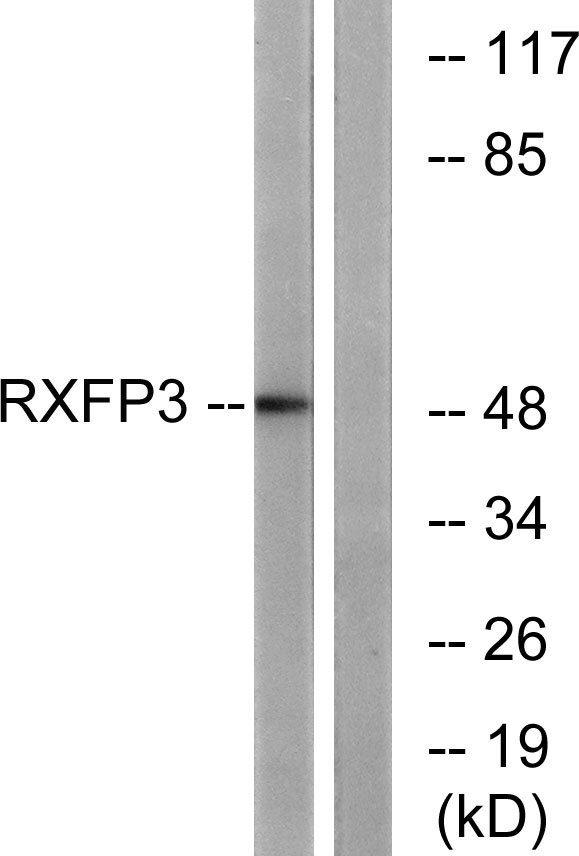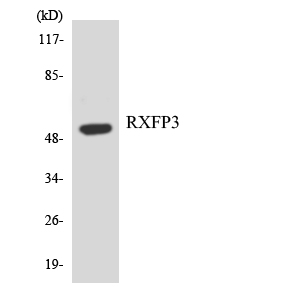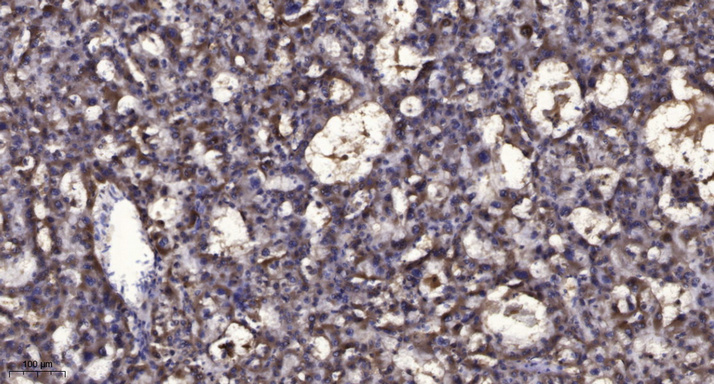Relaxin Receptor 3 Polyclonal Antibody
- Catalog No.:YT4043
- Applications:WB;IHC
- Reactivity:Human;Mouse;Rat
- Target:
- Relaxin Receptor 3
- Fields:
- >>Neuroactive ligand-receptor interaction;>>Relaxin signaling pathway
- Gene Name:
- RXFP3
- Protein Name:
- Relaxin-3 receptor 1
- Human Gene Id:
- 51289
- Human Swiss Prot No:
- Q9NSD7
- Mouse Gene Id:
- 239336
- Mouse Swiss Prot No:
- Q8BGE9
- Immunogen:
- The antiserum was produced against synthesized peptide derived from human RXFP3. AA range:161-210
- Specificity:
- Relaxin Receptor 3 Polyclonal Antibody detects endogenous levels of Relaxin Receptor 3 protein.
- Formulation:
- Liquid in PBS containing 50% glycerol, 0.5% BSA and 0.02% sodium azide.
- Source:
- Polyclonal, Rabbit,IgG
- Dilution:
- WB 1:500-2000;IHC 1:50-300
- Purification:
- The antibody was affinity-purified from rabbit antiserum by affinity-chromatography using epitope-specific immunogen.
- Concentration:
- 1 mg/ml
- Storage Stability:
- -15°C to -25°C/1 year(Do not lower than -25°C)
- Other Name:
- RXFP3;RLN3R1;SALPR;Relaxin-3 receptor 1;RLN3 receptor 1;G protein-coupled receptor SALPR;G-protein coupled receptor GPCR135;Relaxin family peptide receptor 3;Somatostatin- and angiotensin-like peptide receptor
- Observed Band(KD):
- 51kD
- Background:
- function:Receptor for relaxin-3. Binding of the ligand inhibit cAMP accumulation.,similarity:Belongs to the G-protein coupled receptor 1 family.,tissue specificity:Expressed predominantly in brain regions. Highest expression in substantia nigra and pituitary, followed by hippocampus, spinal cord, amygdala, caudate nucleus and corpus callosum, quite low level in cerebellum. In peripheral tissues, relatively high levels in adrenal glands, low levels in pancreas, salivary gland, placenta, mammary gland and testis.,
- Function:
- function:Receptor for relaxin-3. Binding of the ligand inhibit cAMP accumulation.,similarity:Belongs to the G-protein coupled receptor 1 family.,tissue specificity:Expressed predominantly in brain regions. Highest expression in substantia nigra and pituitary, followed by hippocampus, spinal cord, amygdala, caudate nucleus and corpus callosum, quite low level in cerebellum. In peripheral tissues, relatively high levels in adrenal glands, low levels in pancreas, salivary gland, placenta, mammary gland and testis.,
- Subcellular Location:
- Cell membrane; Multi-pass membrane protein.
- Expression:
- Expressed predominantly in brain regions. Highest expression in substantia nigra and pituitary, followed by hippocampus, spinal cord, amygdala, caudate nucleus and corpus callosum, quite low level in cerebellum. In peripheral tissues, relatively high levels in adrenal glands, low levels in pancreas, salivary gland, placenta, mammary gland and testis.
- June 19-2018
- WESTERN IMMUNOBLOTTING PROTOCOL
- June 19-2018
- IMMUNOHISTOCHEMISTRY-PARAFFIN PROTOCOL
- June 19-2018
- IMMUNOFLUORESCENCE PROTOCOL
- September 08-2020
- FLOW-CYTOMEYRT-PROTOCOL
- May 20-2022
- Cell-Based ELISA│解您多样本WB检测之困扰
- July 13-2018
- CELL-BASED-ELISA-PROTOCOL-FOR-ACETYL-PROTEIN
- July 13-2018
- CELL-BASED-ELISA-PROTOCOL-FOR-PHOSPHO-PROTEIN
- July 13-2018
- Antibody-FAQs
- Products Images

- Western blot analysis of lysates from K562 cells, using RXFP3 Antibody. The lane on the right is blocked with the synthesized peptide.

- Western blot analysis of the lysates from Jurkat cells using RXFP3 antibody.

- Immunohistochemical analysis of paraffin-embedded human liver cancer. 1, Antibody was diluted at 1:200(4° overnight). 2, Tris-EDTA,pH9.0 was used for antigen retrieval. 3,Secondary antibody was diluted at 1:200(room temperature, 45min).



